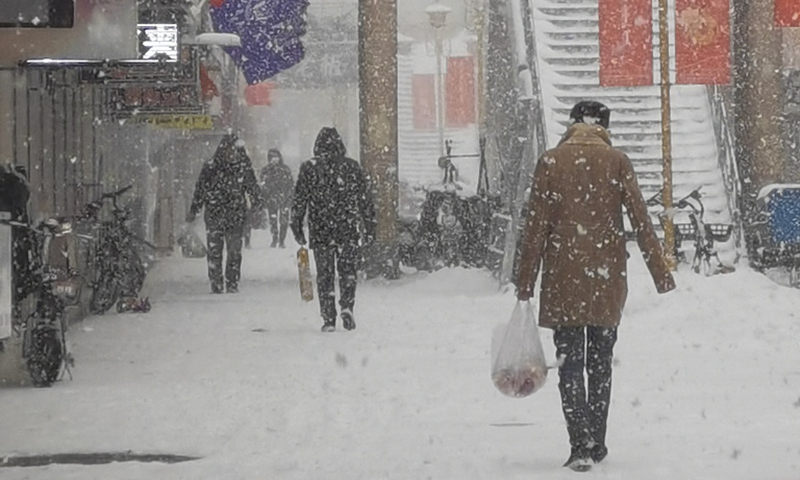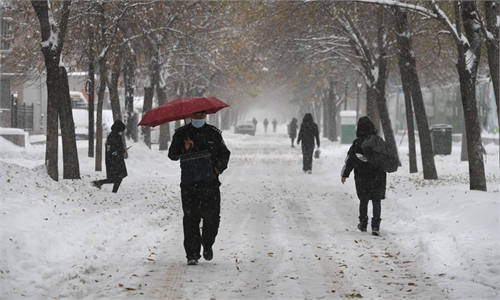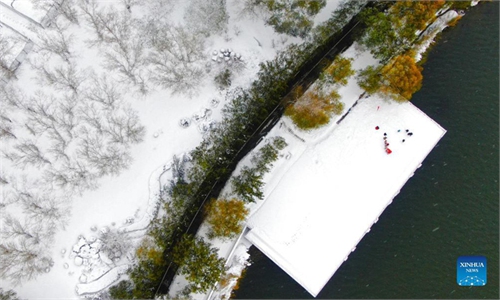
People walk in the snow in Tongliao, North China's Inner Mongolia Autonomous Region,on November 8, 2021. Photo: VCG
As a powerful cold wave began to sweep across the country, North China's Inner Mongolia Autonomous Region and Northeast China's Jilin, Liaoning and Heilongjiang provinces, issued a total of 27 red alerts for heavy blizzards, the highest warning level in China's meteorological system. Some places recorded the highest daily snowfall in decades.
Meteorological researchers at Tongliao, Inner Mongolia, the city most affected by the blizzards, told the Global Times on Tuesday that this snowstorm was an extremely random and sudden extreme weather event, which does not indicate the trend for the winter or that there will be higher snowfall this year.
In the past few days, Tongliao issued five red warnings for blizzards, with many parts of the city breaking the record for daily snowfall. Jilin also scrambled in the earliest cold wave in the past decade, resulting in widespread shutdown of land and air traffic. Heavy snowfalls were also recorded in many parts of Liaoning and Heilongjiang.
China's Ministry of Emergency Management has dispatched two working groups to the four provinces to guide and assist in disaster response and relief work, and it will allocate relief supplies.
An official at the Tongliao Meteorological Bureau surnamed Ma told the Global Times that the city is experiencing the strongest snowfall since meteorological records were kept. Of the 11 national meteorological observation points within the city, seven detected the highest snowfall in history.
Ma attributed the blizzard to an intense convergence of cold and warm air, adding that "as the strongest cold snap in the second half of this year marched northeast, it formed a cut-off cold vortex at a high altitude. On the ground, cyclones were generated near the Yellow and Bohai Seas, transporting strong water vapor from the Yellow Sea and the Sea of Japan to Northeast China, resulting in a large and prolonged snowfall."
Ma also mentioned that "this is just an extremely fortuitous extreme climate phenomenon, and this heavy snowfall does not mean that the northeast will experience more snow this winter or that more snowstorms will occur in the future."
He also mentioned that coincidentally, date in the lunar calendar of the snowstorm in Tongliao coincided with the date of last year's snowstorm.
As of late Monday, one person died and more than 5,600 residents were affected during the heavy snowstorm in Tongliao.
Ma noted that the heavy snowfall was accurately forecasted and reported to the city's emergency management authorities as early as November 2. Subsequently, emergency plans were discussed and employees from relevant government departments were deployed to protect people's lives and properties. After the snow stops, all parties will intensify their rescue efforts.
Tongliao suspended classes for kindergarten, primary and middle school students since Sunday and imposed temporary closures on several highways. In Changchun, capital of Northeast China's Jilin Province, airports were closed. The Xiantao International Airport in Shenyang, Liaoning Province, reopened on Tuesday as the snowfall subsided.
The snowstorm also put pressure on the power grid. Twenty transmission lines in cities in Jilin collapsed and the State Grid Corp of China dispatched nearly 3,000 employees to fix the problem. Transmission lines were back on service as of Tuesday evening.
If the snow does not melt as soon as possible there is the risk of a "white disaster," a common problem in pastoral areas when more than 15 cm of snow piles up on the grassland and livestock cannot graze, China Central Television reported.
The core of the blizzard has passed and the Tongliao Meteorological Bureau expects the snowfall to be largely over between late Tuesday night and early Wednesday morning, Ma said.


